Leadership: A Critical Perspective on Challenges and the Importance of ESG Criteria
VerifiedAdded on 2023/06/08
|12
|3637
|181
AI Summary
The essay explores the concept of leadership, evaluates the success of CEOs, and discusses the challenges they face while focusing on financial metrics. It also highlights the importance of considering ESG criteria and ways leaders can address these challenges.
Contribute Materials
Your contribution can guide someone’s learning journey. Share your
documents today.
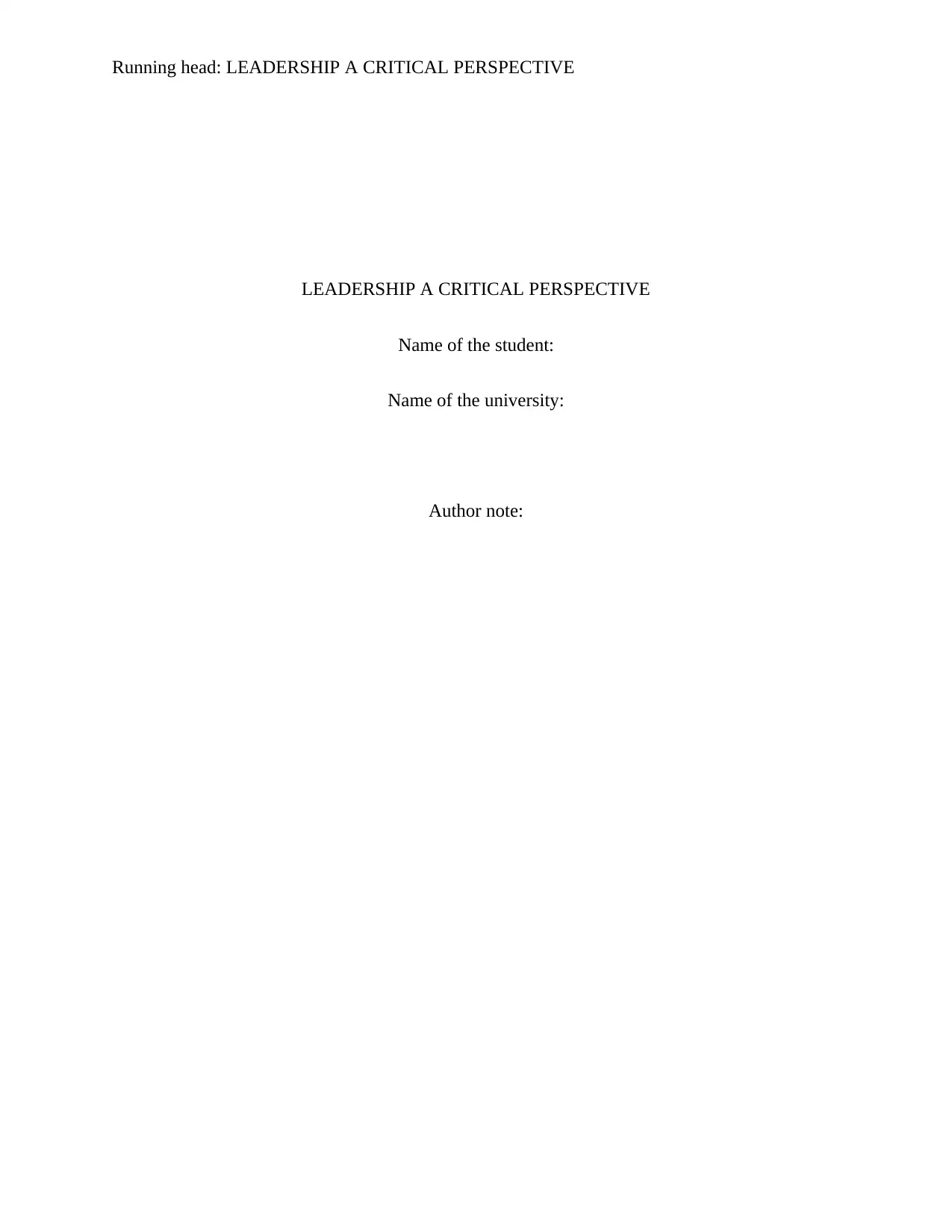
Running head: LEADERSHIP A CRITICAL PERSPECTIVE
LEADERSHIP A CRITICAL PERSPECTIVE
Name of the student:
Name of the university:
Author note:
LEADERSHIP A CRITICAL PERSPECTIVE
Name of the student:
Name of the university:
Author note:
Secure Best Marks with AI Grader
Need help grading? Try our AI Grader for instant feedback on your assignments.
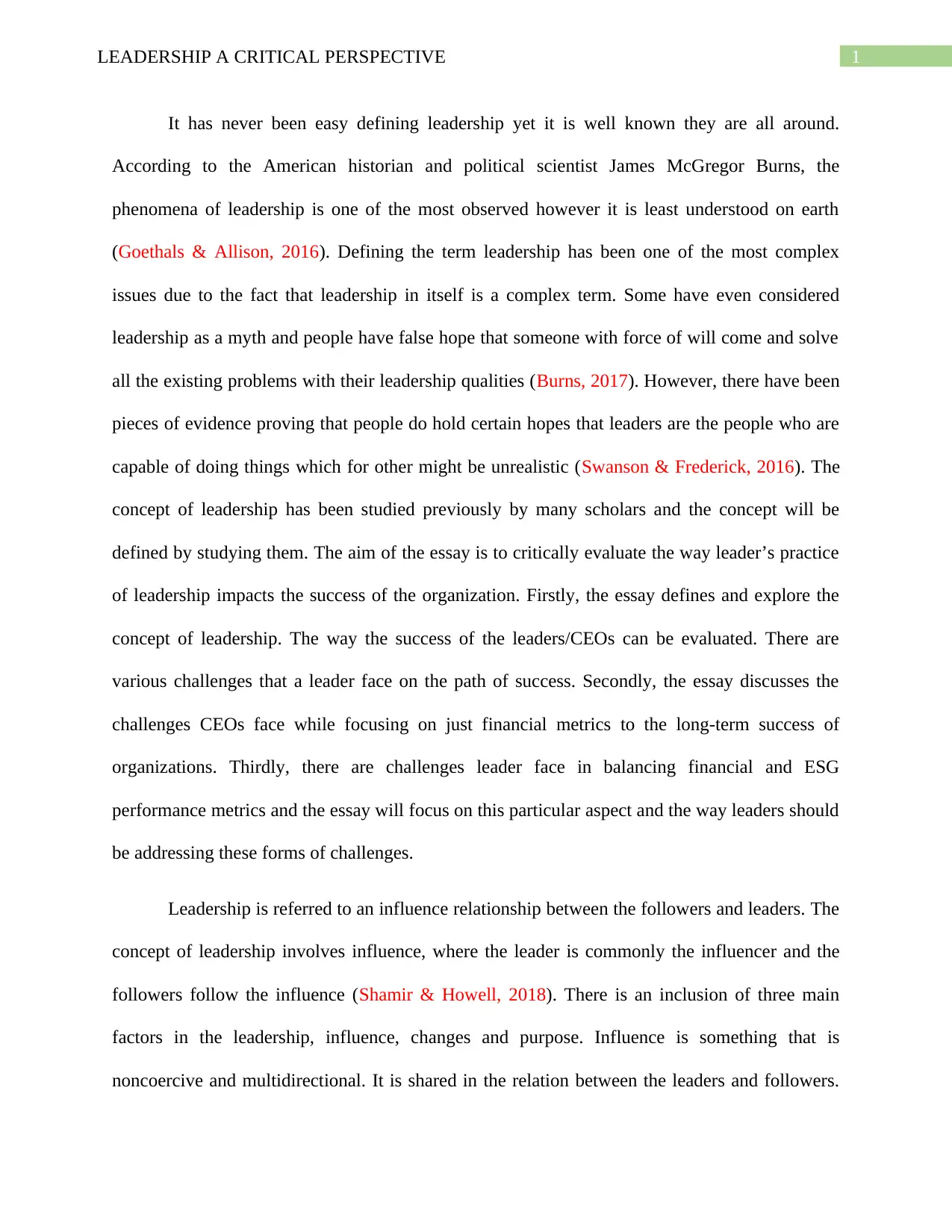
1LEADERSHIP A CRITICAL PERSPECTIVE
It has never been easy defining leadership yet it is well known they are all around.
According to the American historian and political scientist James McGregor Burns, the
phenomena of leadership is one of the most observed however it is least understood on earth
(Goethals & Allison, 2016). Defining the term leadership has been one of the most complex
issues due to the fact that leadership in itself is a complex term. Some have even considered
leadership as a myth and people have false hope that someone with force of will come and solve
all the existing problems with their leadership qualities (Burns, 2017). However, there have been
pieces of evidence proving that people do hold certain hopes that leaders are the people who are
capable of doing things which for other might be unrealistic (Swanson & Frederick, 2016). The
concept of leadership has been studied previously by many scholars and the concept will be
defined by studying them. The aim of the essay is to critically evaluate the way leader’s practice
of leadership impacts the success of the organization. Firstly, the essay defines and explore the
concept of leadership. The way the success of the leaders/CEOs can be evaluated. There are
various challenges that a leader face on the path of success. Secondly, the essay discusses the
challenges CEOs face while focusing on just financial metrics to the long-term success of
organizations. Thirdly, there are challenges leader face in balancing financial and ESG
performance metrics and the essay will focus on this particular aspect and the way leaders should
be addressing these forms of challenges.
Leadership is referred to an influence relationship between the followers and leaders. The
concept of leadership involves influence, where the leader is commonly the influencer and the
followers follow the influence (Shamir & Howell, 2018). There is an inclusion of three main
factors in the leadership, influence, changes and purpose. Influence is something that is
noncoercive and multidirectional. It is shared in the relation between the leaders and followers.
It has never been easy defining leadership yet it is well known they are all around.
According to the American historian and political scientist James McGregor Burns, the
phenomena of leadership is one of the most observed however it is least understood on earth
(Goethals & Allison, 2016). Defining the term leadership has been one of the most complex
issues due to the fact that leadership in itself is a complex term. Some have even considered
leadership as a myth and people have false hope that someone with force of will come and solve
all the existing problems with their leadership qualities (Burns, 2017). However, there have been
pieces of evidence proving that people do hold certain hopes that leaders are the people who are
capable of doing things which for other might be unrealistic (Swanson & Frederick, 2016). The
concept of leadership has been studied previously by many scholars and the concept will be
defined by studying them. The aim of the essay is to critically evaluate the way leader’s practice
of leadership impacts the success of the organization. Firstly, the essay defines and explore the
concept of leadership. The way the success of the leaders/CEOs can be evaluated. There are
various challenges that a leader face on the path of success. Secondly, the essay discusses the
challenges CEOs face while focusing on just financial metrics to the long-term success of
organizations. Thirdly, there are challenges leader face in balancing financial and ESG
performance metrics and the essay will focus on this particular aspect and the way leaders should
be addressing these forms of challenges.
Leadership is referred to an influence relationship between the followers and leaders. The
concept of leadership involves influence, where the leader is commonly the influencer and the
followers follow the influence (Shamir & Howell, 2018). There is an inclusion of three main
factors in the leadership, influence, changes and purpose. Influence is something that is
noncoercive and multidirectional. It is shared in the relation between the leaders and followers.
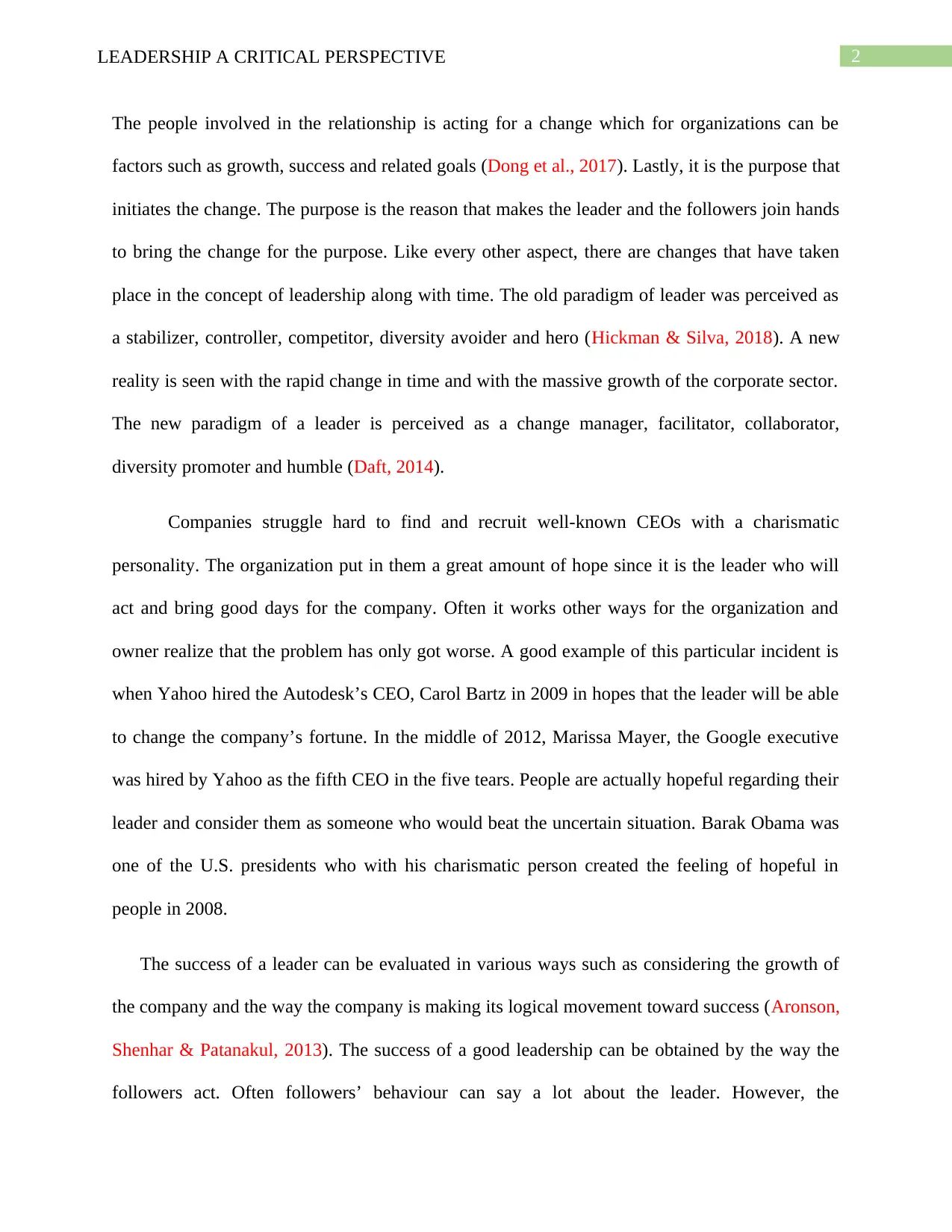
2LEADERSHIP A CRITICAL PERSPECTIVE
The people involved in the relationship is acting for a change which for organizations can be
factors such as growth, success and related goals (Dong et al., 2017). Lastly, it is the purpose that
initiates the change. The purpose is the reason that makes the leader and the followers join hands
to bring the change for the purpose. Like every other aspect, there are changes that have taken
place in the concept of leadership along with time. The old paradigm of leader was perceived as
a stabilizer, controller, competitor, diversity avoider and hero (Hickman & Silva, 2018). A new
reality is seen with the rapid change in time and with the massive growth of the corporate sector.
The new paradigm of a leader is perceived as a change manager, facilitator, collaborator,
diversity promoter and humble (Daft, 2014).
Companies struggle hard to find and recruit well-known CEOs with a charismatic
personality. The organization put in them a great amount of hope since it is the leader who will
act and bring good days for the company. Often it works other ways for the organization and
owner realize that the problem has only got worse. A good example of this particular incident is
when Yahoo hired the Autodesk’s CEO, Carol Bartz in 2009 in hopes that the leader will be able
to change the company’s fortune. In the middle of 2012, Marissa Mayer, the Google executive
was hired by Yahoo as the fifth CEO in the five tears. People are actually hopeful regarding their
leader and consider them as someone who would beat the uncertain situation. Barak Obama was
one of the U.S. presidents who with his charismatic person created the feeling of hopeful in
people in 2008.
The success of a leader can be evaluated in various ways such as considering the growth of
the company and the way the company is making its logical movement toward success (Aronson,
Shenhar & Patanakul, 2013). The success of a good leadership can be obtained by the way the
followers act. Often followers’ behaviour can say a lot about the leader. However, the
The people involved in the relationship is acting for a change which for organizations can be
factors such as growth, success and related goals (Dong et al., 2017). Lastly, it is the purpose that
initiates the change. The purpose is the reason that makes the leader and the followers join hands
to bring the change for the purpose. Like every other aspect, there are changes that have taken
place in the concept of leadership along with time. The old paradigm of leader was perceived as
a stabilizer, controller, competitor, diversity avoider and hero (Hickman & Silva, 2018). A new
reality is seen with the rapid change in time and with the massive growth of the corporate sector.
The new paradigm of a leader is perceived as a change manager, facilitator, collaborator,
diversity promoter and humble (Daft, 2014).
Companies struggle hard to find and recruit well-known CEOs with a charismatic
personality. The organization put in them a great amount of hope since it is the leader who will
act and bring good days for the company. Often it works other ways for the organization and
owner realize that the problem has only got worse. A good example of this particular incident is
when Yahoo hired the Autodesk’s CEO, Carol Bartz in 2009 in hopes that the leader will be able
to change the company’s fortune. In the middle of 2012, Marissa Mayer, the Google executive
was hired by Yahoo as the fifth CEO in the five tears. People are actually hopeful regarding their
leader and consider them as someone who would beat the uncertain situation. Barak Obama was
one of the U.S. presidents who with his charismatic person created the feeling of hopeful in
people in 2008.
The success of a leader can be evaluated in various ways such as considering the growth of
the company and the way the company is making its logical movement toward success (Aronson,
Shenhar & Patanakul, 2013). The success of a good leadership can be obtained by the way the
followers act. Often followers’ behaviour can say a lot about the leader. However, the
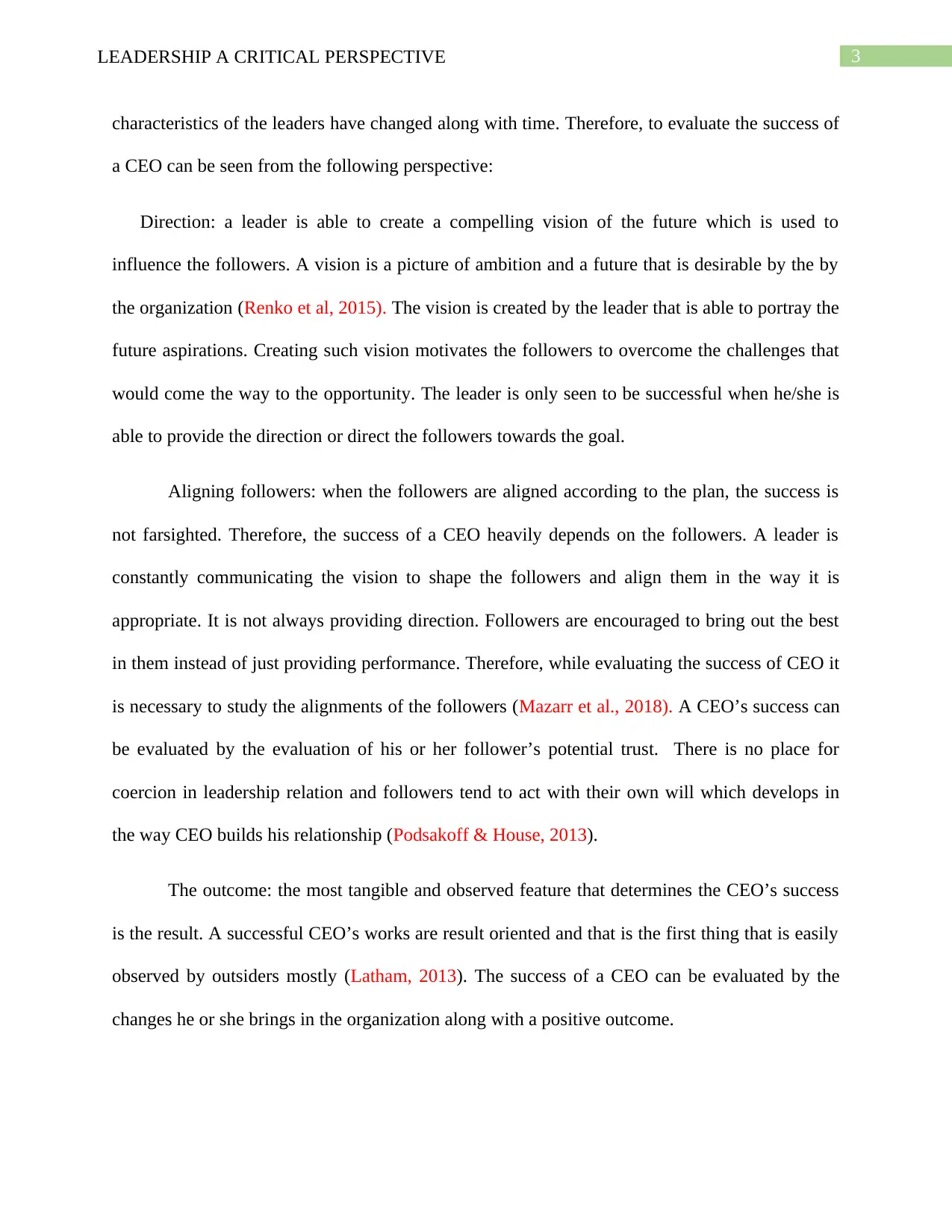
3LEADERSHIP A CRITICAL PERSPECTIVE
characteristics of the leaders have changed along with time. Therefore, to evaluate the success of
a CEO can be seen from the following perspective:
Direction: a leader is able to create a compelling vision of the future which is used to
influence the followers. A vision is a picture of ambition and a future that is desirable by the by
the organization (Renko et al, 2015). The vision is created by the leader that is able to portray the
future aspirations. Creating such vision motivates the followers to overcome the challenges that
would come the way to the opportunity. The leader is only seen to be successful when he/she is
able to provide the direction or direct the followers towards the goal.
Aligning followers: when the followers are aligned according to the plan, the success is
not farsighted. Therefore, the success of a CEO heavily depends on the followers. A leader is
constantly communicating the vision to shape the followers and align them in the way it is
appropriate. It is not always providing direction. Followers are encouraged to bring out the best
in them instead of just providing performance. Therefore, while evaluating the success of CEO it
is necessary to study the alignments of the followers (Mazarr et al., 2018). A CEO’s success can
be evaluated by the evaluation of his or her follower’s potential trust. There is no place for
coercion in leadership relation and followers tend to act with their own will which develops in
the way CEO builds his relationship (Podsakoff & House, 2013).
The outcome: the most tangible and observed feature that determines the CEO’s success
is the result. A successful CEO’s works are result oriented and that is the first thing that is easily
observed by outsiders mostly (Latham, 2013). The success of a CEO can be evaluated by the
changes he or she brings in the organization along with a positive outcome.
characteristics of the leaders have changed along with time. Therefore, to evaluate the success of
a CEO can be seen from the following perspective:
Direction: a leader is able to create a compelling vision of the future which is used to
influence the followers. A vision is a picture of ambition and a future that is desirable by the by
the organization (Renko et al, 2015). The vision is created by the leader that is able to portray the
future aspirations. Creating such vision motivates the followers to overcome the challenges that
would come the way to the opportunity. The leader is only seen to be successful when he/she is
able to provide the direction or direct the followers towards the goal.
Aligning followers: when the followers are aligned according to the plan, the success is
not farsighted. Therefore, the success of a CEO heavily depends on the followers. A leader is
constantly communicating the vision to shape the followers and align them in the way it is
appropriate. It is not always providing direction. Followers are encouraged to bring out the best
in them instead of just providing performance. Therefore, while evaluating the success of CEO it
is necessary to study the alignments of the followers (Mazarr et al., 2018). A CEO’s success can
be evaluated by the evaluation of his or her follower’s potential trust. There is no place for
coercion in leadership relation and followers tend to act with their own will which develops in
the way CEO builds his relationship (Podsakoff & House, 2013).
The outcome: the most tangible and observed feature that determines the CEO’s success
is the result. A successful CEO’s works are result oriented and that is the first thing that is easily
observed by outsiders mostly (Latham, 2013). The success of a CEO can be evaluated by the
changes he or she brings in the organization along with a positive outcome.
Secure Best Marks with AI Grader
Need help grading? Try our AI Grader for instant feedback on your assignments.

4LEADERSHIP A CRITICAL PERSPECTIVE
There is no school of CEOs where one can get the learning of running a company. It is
only through experience that one becomes able to run a business, master it and become
successful. Chief executives must learn the art of leading a company and they will be learning
while everyone is there to watch him or her. It is the job of the senior executives to be
responsible for the decisions and actions were taken in the organization even the ones they are
unaware of. According to evidence, it is found that CEOs between 35 per cent to 50 per cent are
replaced within the span of five years (Mehrotra et al., 2013). CEOs have to come up with ideas
that would make their organization flourish regardless of the product they are selling or the
service they are providing. The philosophy for the CEOs is to decide the right approaches to
leadership. By approaching it includes areas of corporate policies such as strategic planning,
recruitment, Research and development. The attention is toward the kind of people the CEO
prefers in the organization. Therefore with all the leadership approaches mentioned are what
CEOs use to meet the needs of their organization. These are the qualities that are used to evaluate
a CEO’s success.
Many organization believes that it is the performance that is important and matters for the
organization. These companies put numbers or financial metrics in the first place and make the
metrics the benchmark of an organization’s progress (Gunasekaran et al., 2015). However, the
true leaders know that there are various challenges that one has to face when the financial
metrics are given the major priority. The important factors are the non-financial metrics which
are useful for measuring the company’s performance. Leaders are faced with challenges in
various ways and their ability to do the right thing is tested. Leaders are put in places where they
perform tasks such as cutting down costs and increase profit, meet the needs of the vendors and
business partners, and look successful. With all the pressures it becomes hard to maintain the
There is no school of CEOs where one can get the learning of running a company. It is
only through experience that one becomes able to run a business, master it and become
successful. Chief executives must learn the art of leading a company and they will be learning
while everyone is there to watch him or her. It is the job of the senior executives to be
responsible for the decisions and actions were taken in the organization even the ones they are
unaware of. According to evidence, it is found that CEOs between 35 per cent to 50 per cent are
replaced within the span of five years (Mehrotra et al., 2013). CEOs have to come up with ideas
that would make their organization flourish regardless of the product they are selling or the
service they are providing. The philosophy for the CEOs is to decide the right approaches to
leadership. By approaching it includes areas of corporate policies such as strategic planning,
recruitment, Research and development. The attention is toward the kind of people the CEO
prefers in the organization. Therefore with all the leadership approaches mentioned are what
CEOs use to meet the needs of their organization. These are the qualities that are used to evaluate
a CEO’s success.
Many organization believes that it is the performance that is important and matters for the
organization. These companies put numbers or financial metrics in the first place and make the
metrics the benchmark of an organization’s progress (Gunasekaran et al., 2015). However, the
true leaders know that there are various challenges that one has to face when the financial
metrics are given the major priority. The important factors are the non-financial metrics which
are useful for measuring the company’s performance. Leaders are faced with challenges in
various ways and their ability to do the right thing is tested. Leaders are put in places where they
perform tasks such as cutting down costs and increase profit, meet the needs of the vendors and
business partners, and look successful. With all the pressures it becomes hard to maintain the
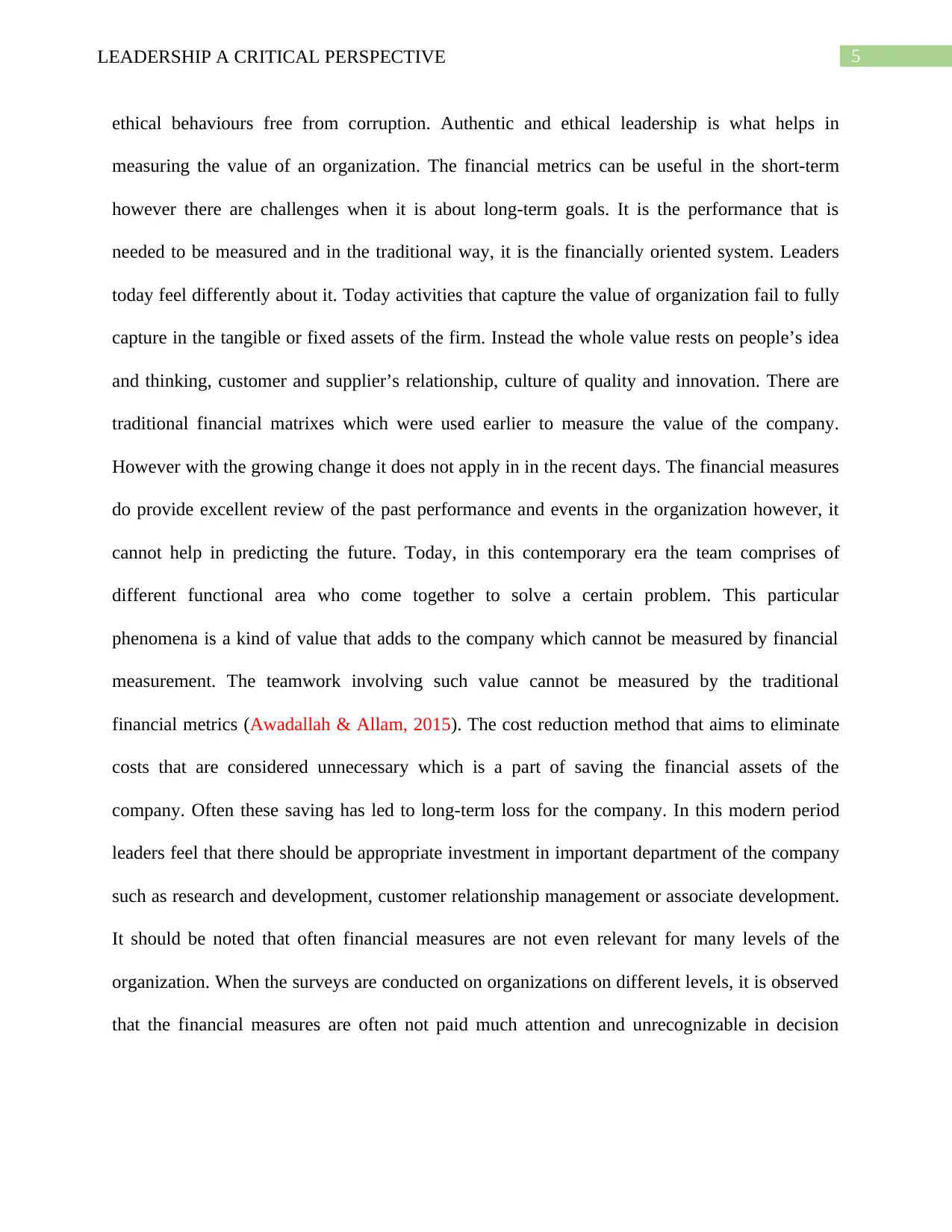
5LEADERSHIP A CRITICAL PERSPECTIVE
ethical behaviours free from corruption. Authentic and ethical leadership is what helps in
measuring the value of an organization. The financial metrics can be useful in the short-term
however there are challenges when it is about long-term goals. It is the performance that is
needed to be measured and in the traditional way, it is the financially oriented system. Leaders
today feel differently about it. Today activities that capture the value of organization fail to fully
capture in the tangible or fixed assets of the firm. Instead the whole value rests on people’s idea
and thinking, customer and supplier’s relationship, culture of quality and innovation. There are
traditional financial matrixes which were used earlier to measure the value of the company.
However with the growing change it does not apply in in the recent days. The financial measures
do provide excellent review of the past performance and events in the organization however, it
cannot help in predicting the future. Today, in this contemporary era the team comprises of
different functional area who come together to solve a certain problem. This particular
phenomena is a kind of value that adds to the company which cannot be measured by financial
measurement. The teamwork involving such value cannot be measured by the traditional
financial metrics (Awadallah & Allam, 2015). The cost reduction method that aims to eliminate
costs that are considered unnecessary which is a part of saving the financial assets of the
company. Often these saving has led to long-term loss for the company. In this modern period
leaders feel that there should be appropriate investment in important department of the company
such as research and development, customer relationship management or associate development.
It should be noted that often financial measures are not even relevant for many levels of the
organization. When the surveys are conducted on organizations on different levels, it is observed
that the financial measures are often not paid much attention and unrecognizable in decision
ethical behaviours free from corruption. Authentic and ethical leadership is what helps in
measuring the value of an organization. The financial metrics can be useful in the short-term
however there are challenges when it is about long-term goals. It is the performance that is
needed to be measured and in the traditional way, it is the financially oriented system. Leaders
today feel differently about it. Today activities that capture the value of organization fail to fully
capture in the tangible or fixed assets of the firm. Instead the whole value rests on people’s idea
and thinking, customer and supplier’s relationship, culture of quality and innovation. There are
traditional financial matrixes which were used earlier to measure the value of the company.
However with the growing change it does not apply in in the recent days. The financial measures
do provide excellent review of the past performance and events in the organization however, it
cannot help in predicting the future. Today, in this contemporary era the team comprises of
different functional area who come together to solve a certain problem. This particular
phenomena is a kind of value that adds to the company which cannot be measured by financial
measurement. The teamwork involving such value cannot be measured by the traditional
financial metrics (Awadallah & Allam, 2015). The cost reduction method that aims to eliminate
costs that are considered unnecessary which is a part of saving the financial assets of the
company. Often these saving has led to long-term loss for the company. In this modern period
leaders feel that there should be appropriate investment in important department of the company
such as research and development, customer relationship management or associate development.
It should be noted that often financial measures are not even relevant for many levels of the
organization. When the surveys are conducted on organizations on different levels, it is observed
that the financial measures are often not paid much attention and unrecognizable in decision

6LEADERSHIP A CRITICAL PERSPECTIVE
making. The only factor that matters for the well-doing companies is the brand recognition and
brand identity.
Consideration of environmental, social and governance metrics is not new. A criterion
that is a set of standards for the operation of the company with social consciousness. The ESG
criteria mainly refer to three factors regarding the company’s ethical impact and sustainable
practices. For example, investors using ESG criteria will determine a company’s impact on
climate change, amount of carbon emission from the company or the water usage. There are
many discussion on ESG issues for it does not get the adequate amount of attention. There is also
a number of reasons that explain why it is not a discussed topic. The main challenge leaders face
in balancing financial and ESG performance is assigning a monetary value to the ESG issues and
integrating them into quantitative models (Love et al., 2013). Since considering ESG criteria has
a direct relationship with the finance of the company, it becomes hard for the company to abide
by it. Leaders cannot always disclose the ESG related facts and therefore, it becomes a challenge
for the leaders to understand the limitation regarding the ESG related disclosure. There is a big
tendency to influence the financial performance of the company in long-term, however, there are
companies that have relatively short-term horizons. Although ESG has positive aspects in the
organization, leaders are constantly faced with challenges. Even with the will to consider ESG
leaders do not get the chance to consider the ESG issue. Lack of demand from the client’s
perspective has become one of the major reason why leaders fail to consider ESG issues. The
major portion of the company ten to value only the material issues. The issues that are not
material are not valued by the customers. There is a lack of information among the population
which is one reason why leaders face a hard time implementing ESG criteria.
making. The only factor that matters for the well-doing companies is the brand recognition and
brand identity.
Consideration of environmental, social and governance metrics is not new. A criterion
that is a set of standards for the operation of the company with social consciousness. The ESG
criteria mainly refer to three factors regarding the company’s ethical impact and sustainable
practices. For example, investors using ESG criteria will determine a company’s impact on
climate change, amount of carbon emission from the company or the water usage. There are
many discussion on ESG issues for it does not get the adequate amount of attention. There is also
a number of reasons that explain why it is not a discussed topic. The main challenge leaders face
in balancing financial and ESG performance is assigning a monetary value to the ESG issues and
integrating them into quantitative models (Love et al., 2013). Since considering ESG criteria has
a direct relationship with the finance of the company, it becomes hard for the company to abide
by it. Leaders cannot always disclose the ESG related facts and therefore, it becomes a challenge
for the leaders to understand the limitation regarding the ESG related disclosure. There is a big
tendency to influence the financial performance of the company in long-term, however, there are
companies that have relatively short-term horizons. Although ESG has positive aspects in the
organization, leaders are constantly faced with challenges. Even with the will to consider ESG
leaders do not get the chance to consider the ESG issue. Lack of demand from the client’s
perspective has become one of the major reason why leaders fail to consider ESG issues. The
major portion of the company ten to value only the material issues. The issues that are not
material are not valued by the customers. There is a lack of information among the population
which is one reason why leaders face a hard time implementing ESG criteria.
Paraphrase This Document
Need a fresh take? Get an instant paraphrase of this document with our AI Paraphraser
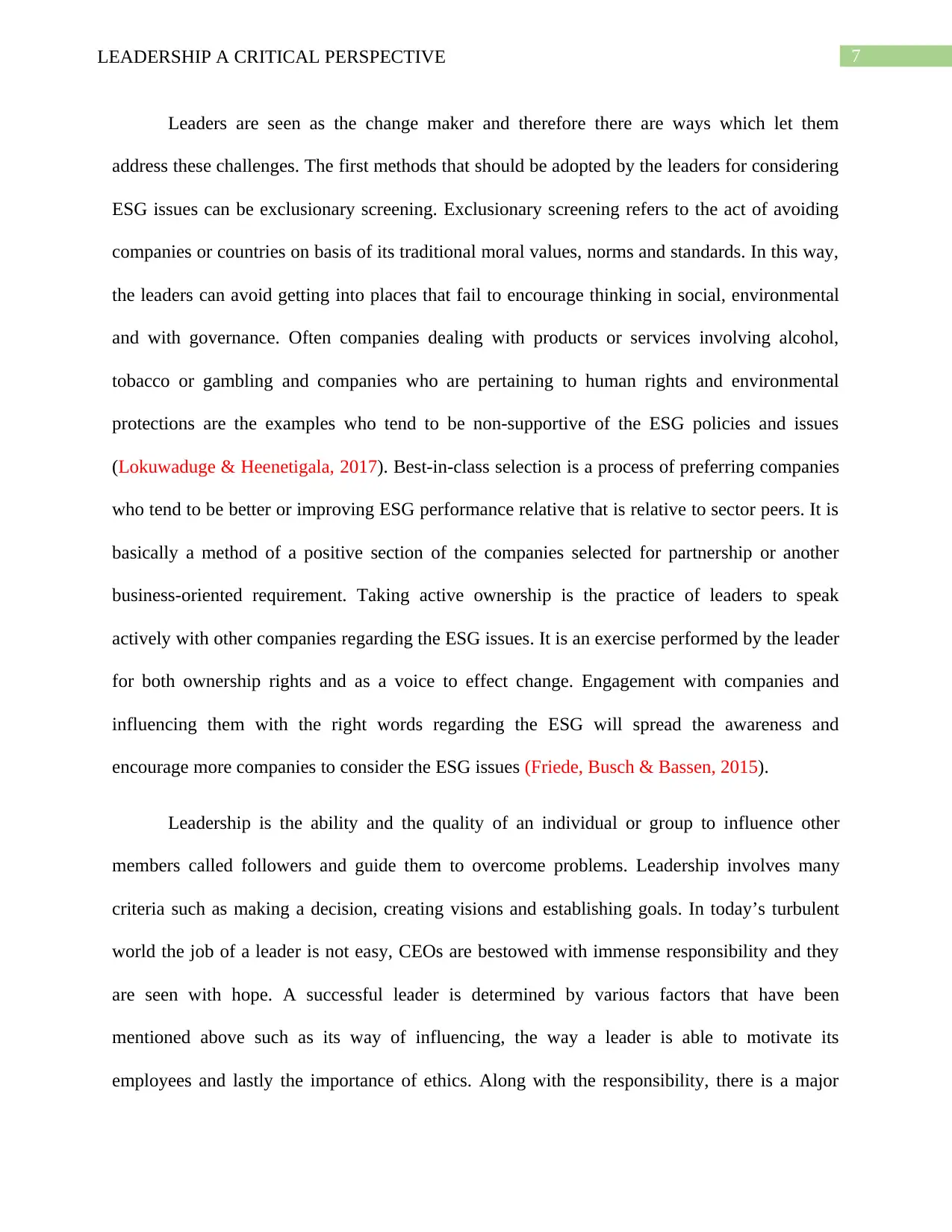
7LEADERSHIP A CRITICAL PERSPECTIVE
Leaders are seen as the change maker and therefore there are ways which let them
address these challenges. The first methods that should be adopted by the leaders for considering
ESG issues can be exclusionary screening. Exclusionary screening refers to the act of avoiding
companies or countries on basis of its traditional moral values, norms and standards. In this way,
the leaders can avoid getting into places that fail to encourage thinking in social, environmental
and with governance. Often companies dealing with products or services involving alcohol,
tobacco or gambling and companies who are pertaining to human rights and environmental
protections are the examples who tend to be non-supportive of the ESG policies and issues
(Lokuwaduge & Heenetigala, 2017). Best-in-class selection is a process of preferring companies
who tend to be better or improving ESG performance relative that is relative to sector peers. It is
basically a method of a positive section of the companies selected for partnership or another
business-oriented requirement. Taking active ownership is the practice of leaders to speak
actively with other companies regarding the ESG issues. It is an exercise performed by the leader
for both ownership rights and as a voice to effect change. Engagement with companies and
influencing them with the right words regarding the ESG will spread the awareness and
encourage more companies to consider the ESG issues (Friede, Busch & Bassen, 2015).
Leadership is the ability and the quality of an individual or group to influence other
members called followers and guide them to overcome problems. Leadership involves many
criteria such as making a decision, creating visions and establishing goals. In today’s turbulent
world the job of a leader is not easy, CEOs are bestowed with immense responsibility and they
are seen with hope. A successful leader is determined by various factors that have been
mentioned above such as its way of influencing, the way a leader is able to motivate its
employees and lastly the importance of ethics. Along with the responsibility, there is a major
Leaders are seen as the change maker and therefore there are ways which let them
address these challenges. The first methods that should be adopted by the leaders for considering
ESG issues can be exclusionary screening. Exclusionary screening refers to the act of avoiding
companies or countries on basis of its traditional moral values, norms and standards. In this way,
the leaders can avoid getting into places that fail to encourage thinking in social, environmental
and with governance. Often companies dealing with products or services involving alcohol,
tobacco or gambling and companies who are pertaining to human rights and environmental
protections are the examples who tend to be non-supportive of the ESG policies and issues
(Lokuwaduge & Heenetigala, 2017). Best-in-class selection is a process of preferring companies
who tend to be better or improving ESG performance relative that is relative to sector peers. It is
basically a method of a positive section of the companies selected for partnership or another
business-oriented requirement. Taking active ownership is the practice of leaders to speak
actively with other companies regarding the ESG issues. It is an exercise performed by the leader
for both ownership rights and as a voice to effect change. Engagement with companies and
influencing them with the right words regarding the ESG will spread the awareness and
encourage more companies to consider the ESG issues (Friede, Busch & Bassen, 2015).
Leadership is the ability and the quality of an individual or group to influence other
members called followers and guide them to overcome problems. Leadership involves many
criteria such as making a decision, creating visions and establishing goals. In today’s turbulent
world the job of a leader is not easy, CEOs are bestowed with immense responsibility and they
are seen with hope. A successful leader is determined by various factors that have been
mentioned above such as its way of influencing, the way a leader is able to motivate its
employees and lastly the importance of ethics. Along with the responsibility, there is a major
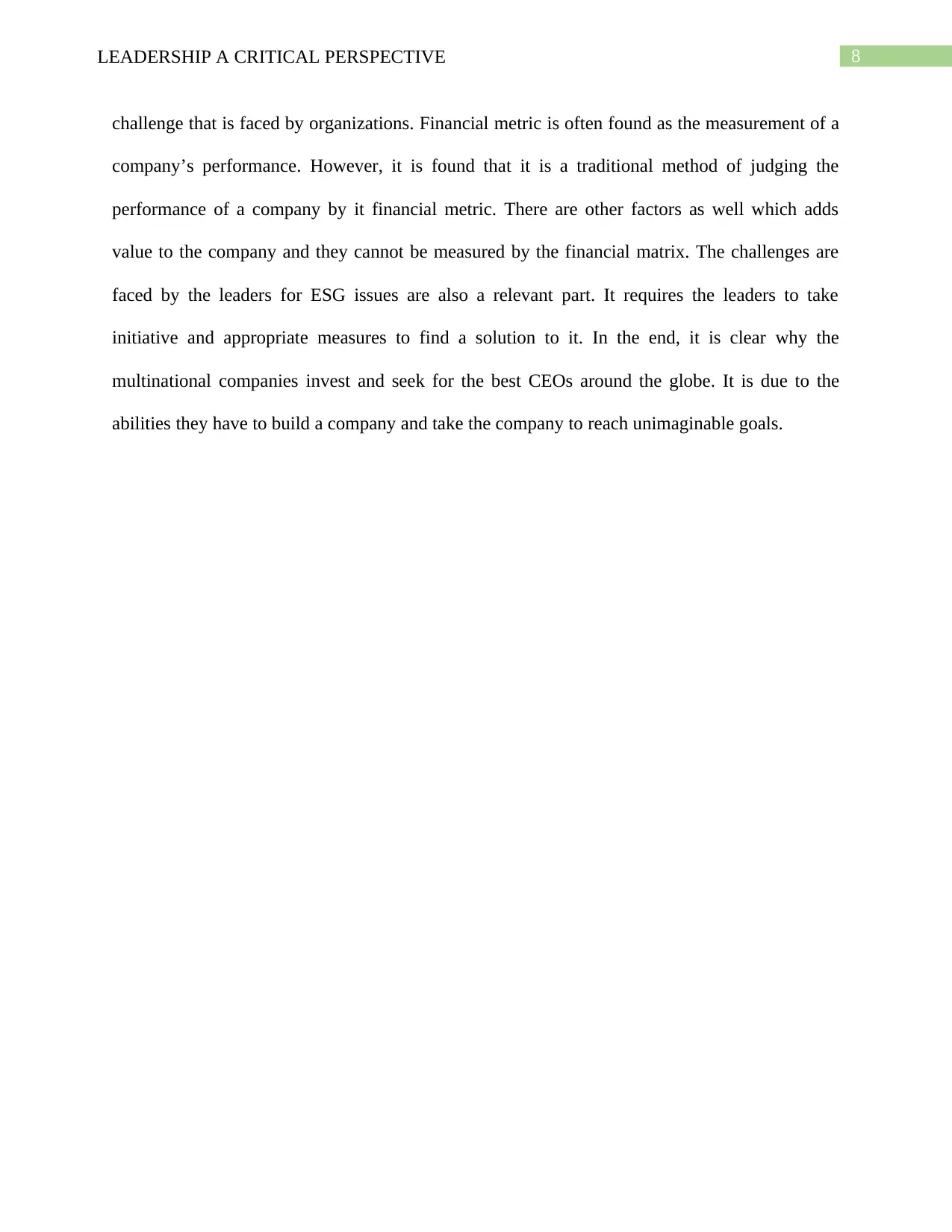
8LEADERSHIP A CRITICAL PERSPECTIVE
challenge that is faced by organizations. Financial metric is often found as the measurement of a
company’s performance. However, it is found that it is a traditional method of judging the
performance of a company by it financial metric. There are other factors as well which adds
value to the company and they cannot be measured by the financial matrix. The challenges are
faced by the leaders for ESG issues are also a relevant part. It requires the leaders to take
initiative and appropriate measures to find a solution to it. In the end, it is clear why the
multinational companies invest and seek for the best CEOs around the globe. It is due to the
abilities they have to build a company and take the company to reach unimaginable goals.
challenge that is faced by organizations. Financial metric is often found as the measurement of a
company’s performance. However, it is found that it is a traditional method of judging the
performance of a company by it financial metric. There are other factors as well which adds
value to the company and they cannot be measured by the financial matrix. The challenges are
faced by the leaders for ESG issues are also a relevant part. It requires the leaders to take
initiative and appropriate measures to find a solution to it. In the end, it is clear why the
multinational companies invest and seek for the best CEOs around the globe. It is due to the
abilities they have to build a company and take the company to reach unimaginable goals.

9LEADERSHIP A CRITICAL PERSPECTIVE
Reference:
Aronson, Z. H., Shenhar, A. J., & Patanakul, P. (2013). Managing the intangible aspects of a
project: the affect of vision, artifacts, and leader values on project spirit and success
in technology‐driven projects. Project Management Journal, 44(1), 35-58.
Awadallah, E. A., & Allam, A. (2015). A critique of the balanced scorecard as a performance
measurement tool. International Journal of Business and Social Science, 6(7), 91-99.
Burns, J. M. (2017). All of Us Is Smarter than One of Us. How Can You Become the Boss?:
From Personal Mastery to Organizational Transformation, 109.
Daft, R. L. (2014). The leadership experience. Cengage Learning.
Dong, Y., Bartol, K. M., Zhang, Z. X., & Li, C. (2017). Enhancing employee creativity via
individual skill development and team knowledge sharing: Influences of dual‐focused
transformational leadership. Journal of Organizational Behavior, 38(3), 439-458.
Friede, G., Busch, T., & Bassen, A. (2015). ESG and financial performance: aggregated
evidence from more than 2000 empirical studies. Journal of Sustainable Finance &
Investment, 5(4), 210-233. doi:10.1080/20430795.2015.1118917
Goethals, G. R., & Allison, S. T. (2016). Transforming motives and mentors: The heroic
leadership of James MacGregor Burns. Unpublished manuscript, University of
Richmond.
Gunasekaran, A., Irani, Z., Choy, K. L., Filippi, L., & Papadopoulos, T. (2015). Performance
measures and metrics in outsourcing decisions: A review for research and
Reference:
Aronson, Z. H., Shenhar, A. J., & Patanakul, P. (2013). Managing the intangible aspects of a
project: the affect of vision, artifacts, and leader values on project spirit and success
in technology‐driven projects. Project Management Journal, 44(1), 35-58.
Awadallah, E. A., & Allam, A. (2015). A critique of the balanced scorecard as a performance
measurement tool. International Journal of Business and Social Science, 6(7), 91-99.
Burns, J. M. (2017). All of Us Is Smarter than One of Us. How Can You Become the Boss?:
From Personal Mastery to Organizational Transformation, 109.
Daft, R. L. (2014). The leadership experience. Cengage Learning.
Dong, Y., Bartol, K. M., Zhang, Z. X., & Li, C. (2017). Enhancing employee creativity via
individual skill development and team knowledge sharing: Influences of dual‐focused
transformational leadership. Journal of Organizational Behavior, 38(3), 439-458.
Friede, G., Busch, T., & Bassen, A. (2015). ESG and financial performance: aggregated
evidence from more than 2000 empirical studies. Journal of Sustainable Finance &
Investment, 5(4), 210-233. doi:10.1080/20430795.2015.1118917
Goethals, G. R., & Allison, S. T. (2016). Transforming motives and mentors: The heroic
leadership of James MacGregor Burns. Unpublished manuscript, University of
Richmond.
Gunasekaran, A., Irani, Z., Choy, K. L., Filippi, L., & Papadopoulos, T. (2015). Performance
measures and metrics in outsourcing decisions: A review for research and
Secure Best Marks with AI Grader
Need help grading? Try our AI Grader for instant feedback on your assignments.
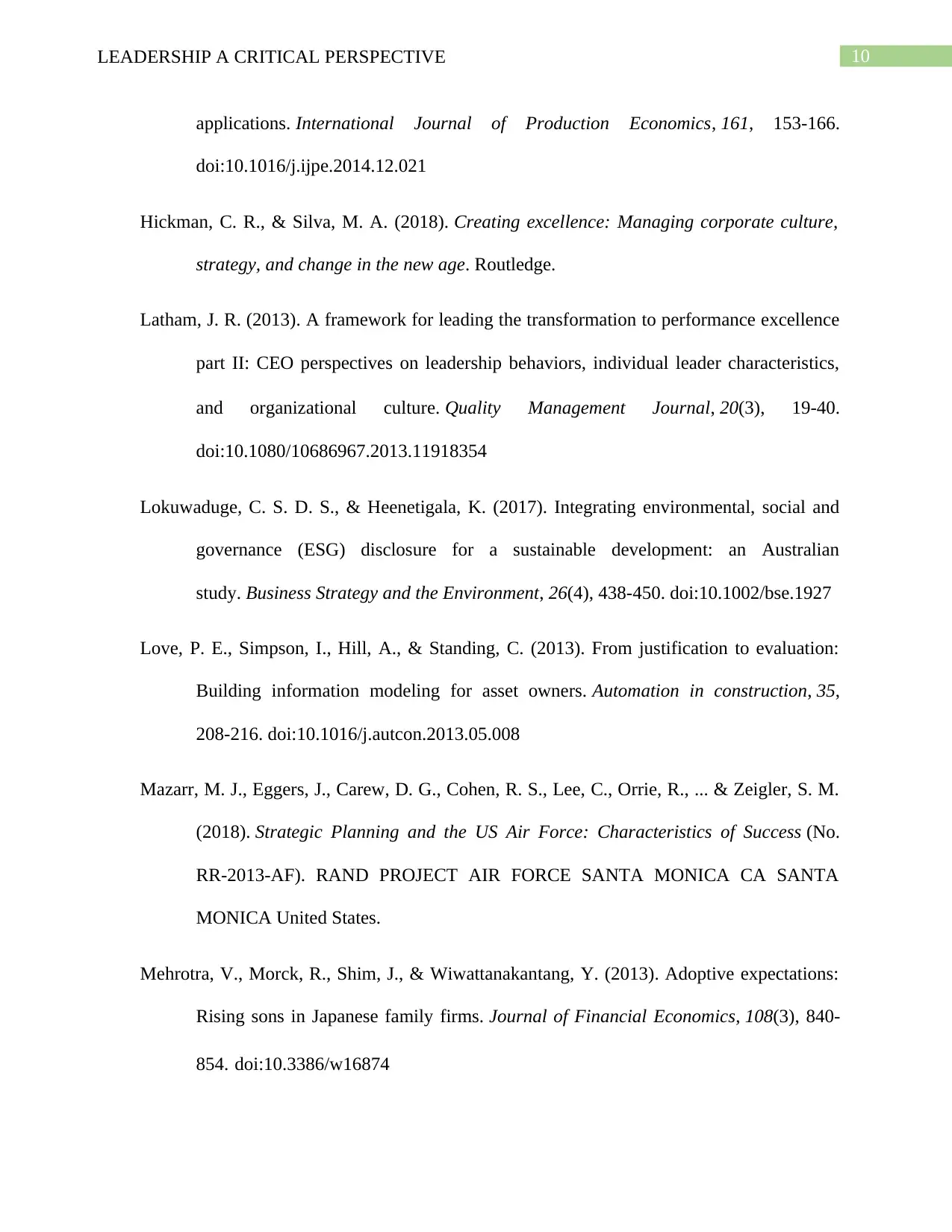
10LEADERSHIP A CRITICAL PERSPECTIVE
applications. International Journal of Production Economics, 161, 153-166.
doi:10.1016/j.ijpe.2014.12.021
Hickman, C. R., & Silva, M. A. (2018). Creating excellence: Managing corporate culture,
strategy, and change in the new age. Routledge.
Latham, J. R. (2013). A framework for leading the transformation to performance excellence
part II: CEO perspectives on leadership behaviors, individual leader characteristics,
and organizational culture. Quality Management Journal, 20(3), 19-40.
doi:10.1080/10686967.2013.11918354
Lokuwaduge, C. S. D. S., & Heenetigala, K. (2017). Integrating environmental, social and
governance (ESG) disclosure for a sustainable development: an Australian
study. Business Strategy and the Environment, 26(4), 438-450. doi:10.1002/bse.1927
Love, P. E., Simpson, I., Hill, A., & Standing, C. (2013). From justification to evaluation:
Building information modeling for asset owners. Automation in construction, 35,
208-216. doi:10.1016/j.autcon.2013.05.008
Mazarr, M. J., Eggers, J., Carew, D. G., Cohen, R. S., Lee, C., Orrie, R., ... & Zeigler, S. M.
(2018). Strategic Planning and the US Air Force: Characteristics of Success (No.
RR-2013-AF). RAND PROJECT AIR FORCE SANTA MONICA CA SANTA
MONICA United States.
Mehrotra, V., Morck, R., Shim, J., & Wiwattanakantang, Y. (2013). Adoptive expectations:
Rising sons in Japanese family firms. Journal of Financial Economics, 108(3), 840-
854. doi:10.3386/w16874
applications. International Journal of Production Economics, 161, 153-166.
doi:10.1016/j.ijpe.2014.12.021
Hickman, C. R., & Silva, M. A. (2018). Creating excellence: Managing corporate culture,
strategy, and change in the new age. Routledge.
Latham, J. R. (2013). A framework for leading the transformation to performance excellence
part II: CEO perspectives on leadership behaviors, individual leader characteristics,
and organizational culture. Quality Management Journal, 20(3), 19-40.
doi:10.1080/10686967.2013.11918354
Lokuwaduge, C. S. D. S., & Heenetigala, K. (2017). Integrating environmental, social and
governance (ESG) disclosure for a sustainable development: an Australian
study. Business Strategy and the Environment, 26(4), 438-450. doi:10.1002/bse.1927
Love, P. E., Simpson, I., Hill, A., & Standing, C. (2013). From justification to evaluation:
Building information modeling for asset owners. Automation in construction, 35,
208-216. doi:10.1016/j.autcon.2013.05.008
Mazarr, M. J., Eggers, J., Carew, D. G., Cohen, R. S., Lee, C., Orrie, R., ... & Zeigler, S. M.
(2018). Strategic Planning and the US Air Force: Characteristics of Success (No.
RR-2013-AF). RAND PROJECT AIR FORCE SANTA MONICA CA SANTA
MONICA United States.
Mehrotra, V., Morck, R., Shim, J., & Wiwattanakantang, Y. (2013). Adoptive expectations:
Rising sons in Japanese family firms. Journal of Financial Economics, 108(3), 840-
854. doi:10.3386/w16874
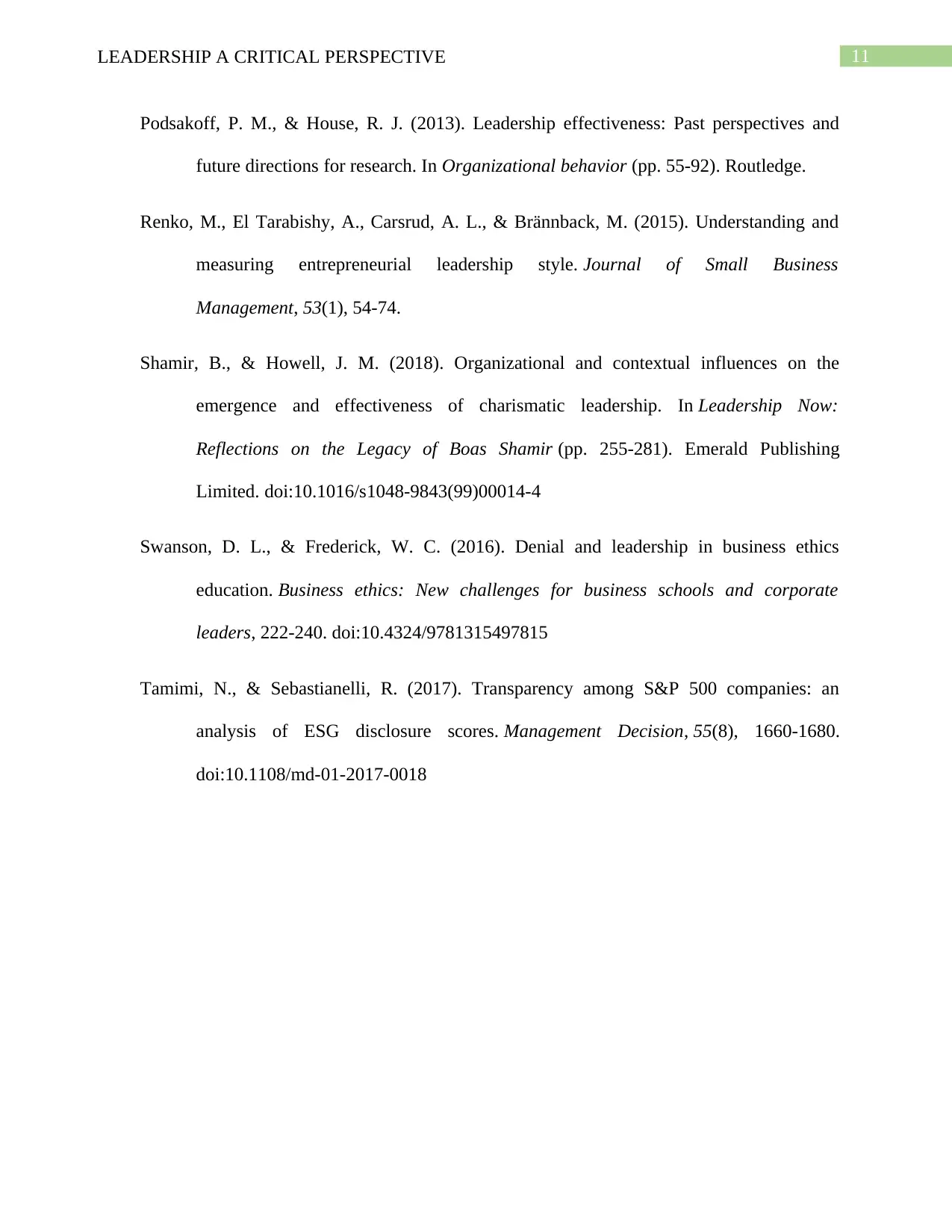
11LEADERSHIP A CRITICAL PERSPECTIVE
Podsakoff, P. M., & House, R. J. (2013). Leadership effectiveness: Past perspectives and
future directions for research. In Organizational behavior (pp. 55-92). Routledge.
Renko, M., El Tarabishy, A., Carsrud, A. L., & Brännback, M. (2015). Understanding and
measuring entrepreneurial leadership style. Journal of Small Business
Management, 53(1), 54-74.
Shamir, B., & Howell, J. M. (2018). Organizational and contextual influences on the
emergence and effectiveness of charismatic leadership. In Leadership Now:
Reflections on the Legacy of Boas Shamir (pp. 255-281). Emerald Publishing
Limited. doi:10.1016/s1048-9843(99)00014-4
Swanson, D. L., & Frederick, W. C. (2016). Denial and leadership in business ethics
education. Business ethics: New challenges for business schools and corporate
leaders, 222-240. doi:10.4324/9781315497815
Tamimi, N., & Sebastianelli, R. (2017). Transparency among S&P 500 companies: an
analysis of ESG disclosure scores. Management Decision, 55(8), 1660-1680.
doi:10.1108/md-01-2017-0018
Podsakoff, P. M., & House, R. J. (2013). Leadership effectiveness: Past perspectives and
future directions for research. In Organizational behavior (pp. 55-92). Routledge.
Renko, M., El Tarabishy, A., Carsrud, A. L., & Brännback, M. (2015). Understanding and
measuring entrepreneurial leadership style. Journal of Small Business
Management, 53(1), 54-74.
Shamir, B., & Howell, J. M. (2018). Organizational and contextual influences on the
emergence and effectiveness of charismatic leadership. In Leadership Now:
Reflections on the Legacy of Boas Shamir (pp. 255-281). Emerald Publishing
Limited. doi:10.1016/s1048-9843(99)00014-4
Swanson, D. L., & Frederick, W. C. (2016). Denial and leadership in business ethics
education. Business ethics: New challenges for business schools and corporate
leaders, 222-240. doi:10.4324/9781315497815
Tamimi, N., & Sebastianelli, R. (2017). Transparency among S&P 500 companies: an
analysis of ESG disclosure scores. Management Decision, 55(8), 1660-1680.
doi:10.1108/md-01-2017-0018
1 out of 12
Related Documents
Your All-in-One AI-Powered Toolkit for Academic Success.
+13062052269
info@desklib.com
Available 24*7 on WhatsApp / Email
![[object Object]](/_next/static/media/star-bottom.7253800d.svg)
Unlock your academic potential
© 2024 | Zucol Services PVT LTD | All rights reserved.





